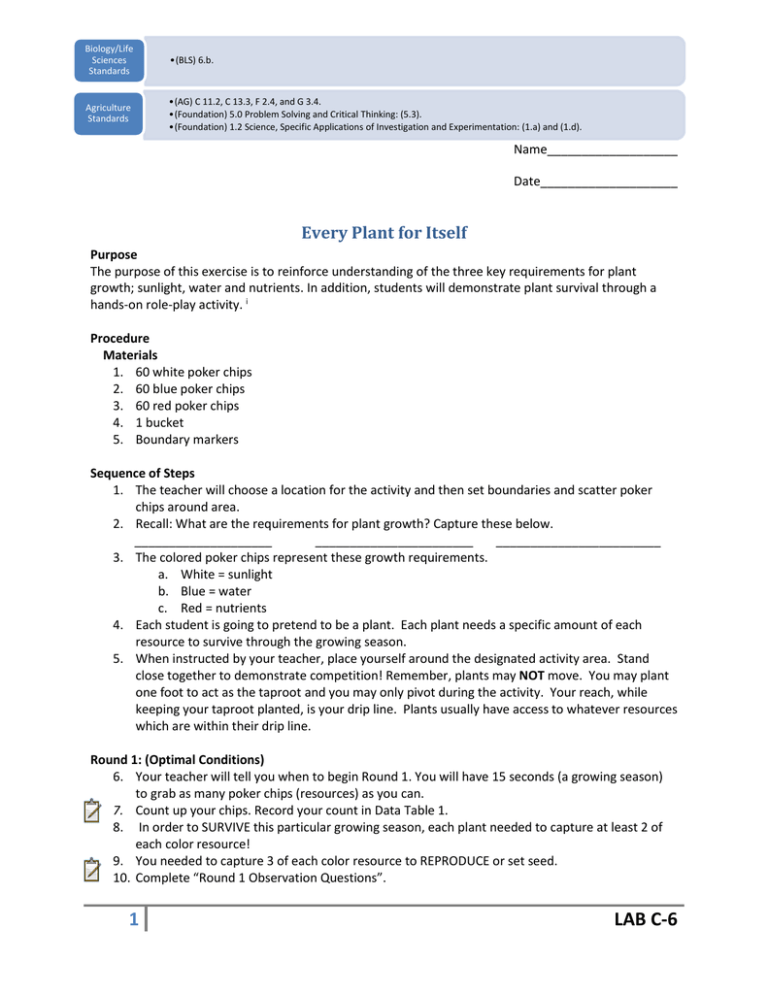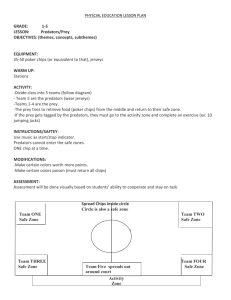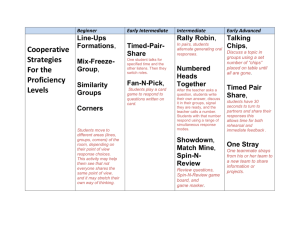C-6 Every Plant for Itself
advertisement

Biology/Life Sciences Standards •(BLS) 6.b. Agriculture Standards •(AG) C 11.2, C 13.3, F 2.4, and G 3.4. •(Foundation) 5.0 Problem Solving and Critical Thinking: (5.3). •(Foundation) 1.2 Science, Specific Applications of Investigation and Experimentation: (1.a) and (1.d). Name___________________ Date____________________ Every Plant for Itself Purpose The purpose of this exercise is to reinforce understanding of the three key requirements for plant growth; sunlight, water and nutrients. In addition, students will demonstrate plant survival through a hands-on role-play activity. i Procedure Materials 1. 60 white poker chips 2. 60 blue poker chips 3. 60 red poker chips 4. 1 bucket 5. Boundary markers Sequence of Steps 1. The teacher will choose a location for the activity and then set boundaries and scatter poker chips around area. 2. Recall: What are the requirements for plant growth? Capture these below. ____________________ _______________________ ________________________ 3. The colored poker chips represent these growth requirements. a. White = sunlight b. Blue = water c. Red = nutrients 4. Each student is going to pretend to be a plant. Each plant needs a specific amount of each resource to survive through the growing season. 5. When instructed by your teacher, place yourself around the designated activity area. Stand close together to demonstrate competition! Remember, plants may NOT move. You may plant one foot to act as the taproot and you may only pivot during the activity. Your reach, while keeping your taproot planted, is your drip line. Plants usually have access to whatever resources which are within their drip line. Round 1: (Optimal Conditions) 6. Your teacher will tell you when to begin Round 1. You will have 15 seconds (a growing season) to grab as many poker chips (resources) as you can. 7. Count up your chips. Record your count in Data Table 1. 8. In order to SURVIVE this particular growing season, each plant needed to capture at least 2 of each color resource! 9. You needed to capture 3 of each color resource to REPRODUCE or set seed. 10. Complete “Round 1 Observation Questions”. 1 LAB C-6 Round 2: (Drought) 11. The teacher will collect all chips and remove 20 blue chips from the bucket. There is going to be a drought in this next growing season! 12. The teacher will scatter the chips around the area. Replant yourself if you have moved. When your teacher tells you to begin, you will have 15 seconds (a growing season) to grab as many poker chips (resources) as you can. 13. Count your chips. Record your count in Data Table 1. 14. In order to survive this particular growing season each plant needed to capture at least 2 of each color resource. 15. In order to reproduce you needed to capture at least 3 of each color resource. 16. Complete “Round 2 Observation Questions”. Round 3: (Limited Nutrients in Crop Field): – OPTIONAL if time is limited 17. The teacher will collect all chips and replace the 20 blue chips in the bucket. The teacher will then remove 20 red chips from the bucket. 18. The teacher will scatter the chips around the area. 19. Students will be “planted” in 4 rows of 5, drip line to drip line, in the area. 20. When your teacher says to begin, you will have 15 seconds (a growing season) to grab as many poker chips (resources) as you can. 21. Count up your chips. Record your count in Data Table 1. 22. In order to survive this particular growing season each plant needed to capture at least 2 of each color resource. 23. In order to reproduce you needed to capture at least 3 of each color resource. 2 LAB C-6 Observations Data Table 1 # White Chips - Sunlight # Blue Chips – Water # Red Chips – Nutrients Survive? Y/N Reproduce? Y/N Round 1 Round 2 Round 3 Round 1 Observation Questions 1. What happened to plants on the edge of the growing area? 2. What happened to plants in the center? 3. Did any plants compete for resources? In the agricultural environment what would we think of as competing plants? Round 2 Observation Questions 1. How many plants survived? 2. How many plants were able to set seed? 3. Did any plants have more resources than they needed? 3 LAB C-6 Round 3 Observation Questions 1. You were placed in equal rows. What do you think this placement simulates? 2. How does this placement help the plants? 3. How many plants survived? 4. Did any plants have more resources than they needed? 5. Did you notice that it was harder to find nutrients (red chips)? 6. Can you think of a real world example of when nutrients might be lacking in a farm field? 7. How is this problem addressed in traditional Western farming? i Sakugawa, J. (2008). Every plant for itself. Mt. San Antonio College. 4 LAB C-6



